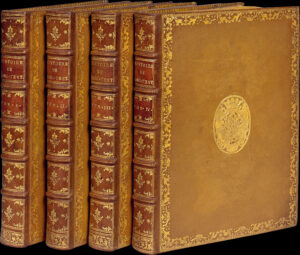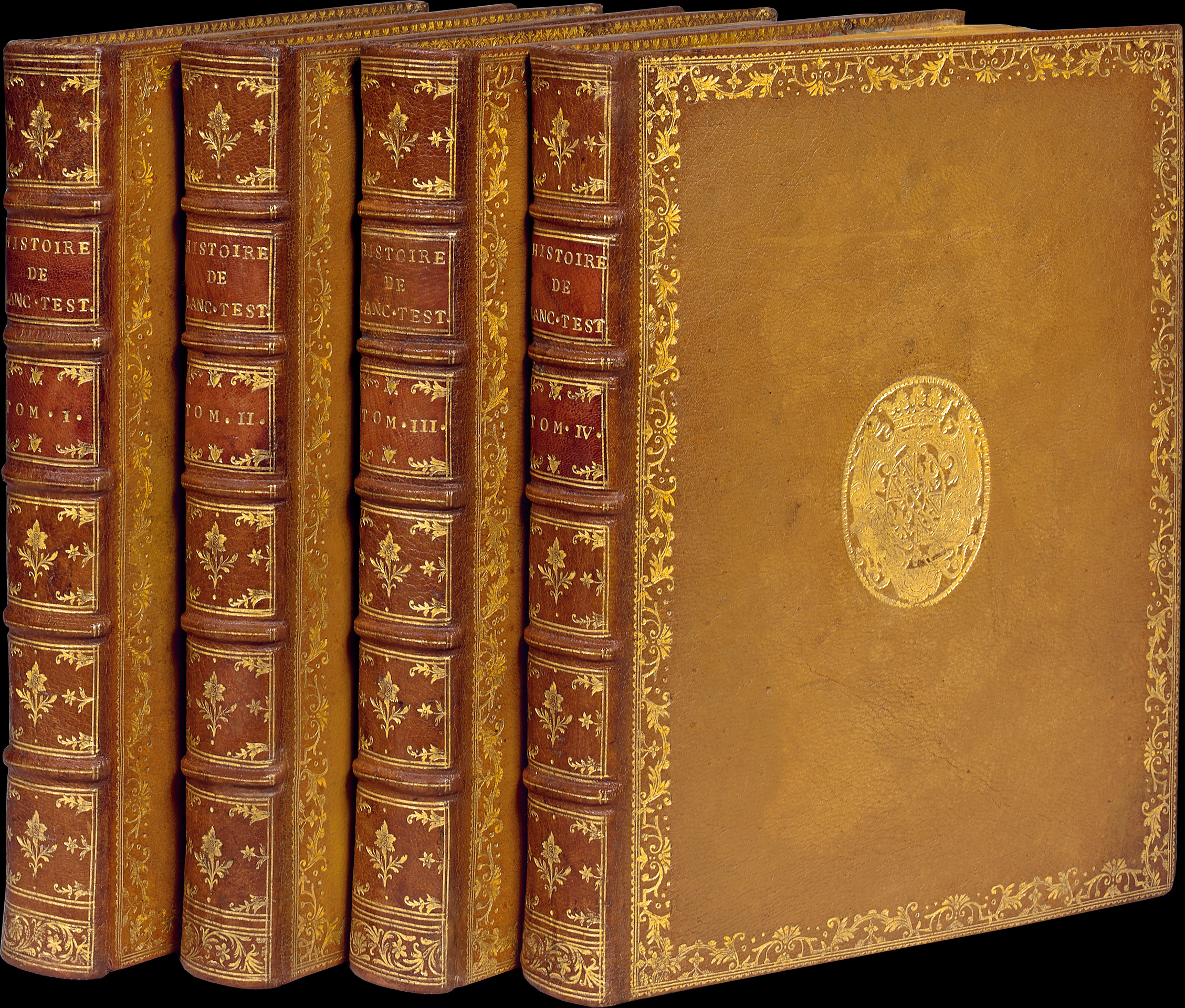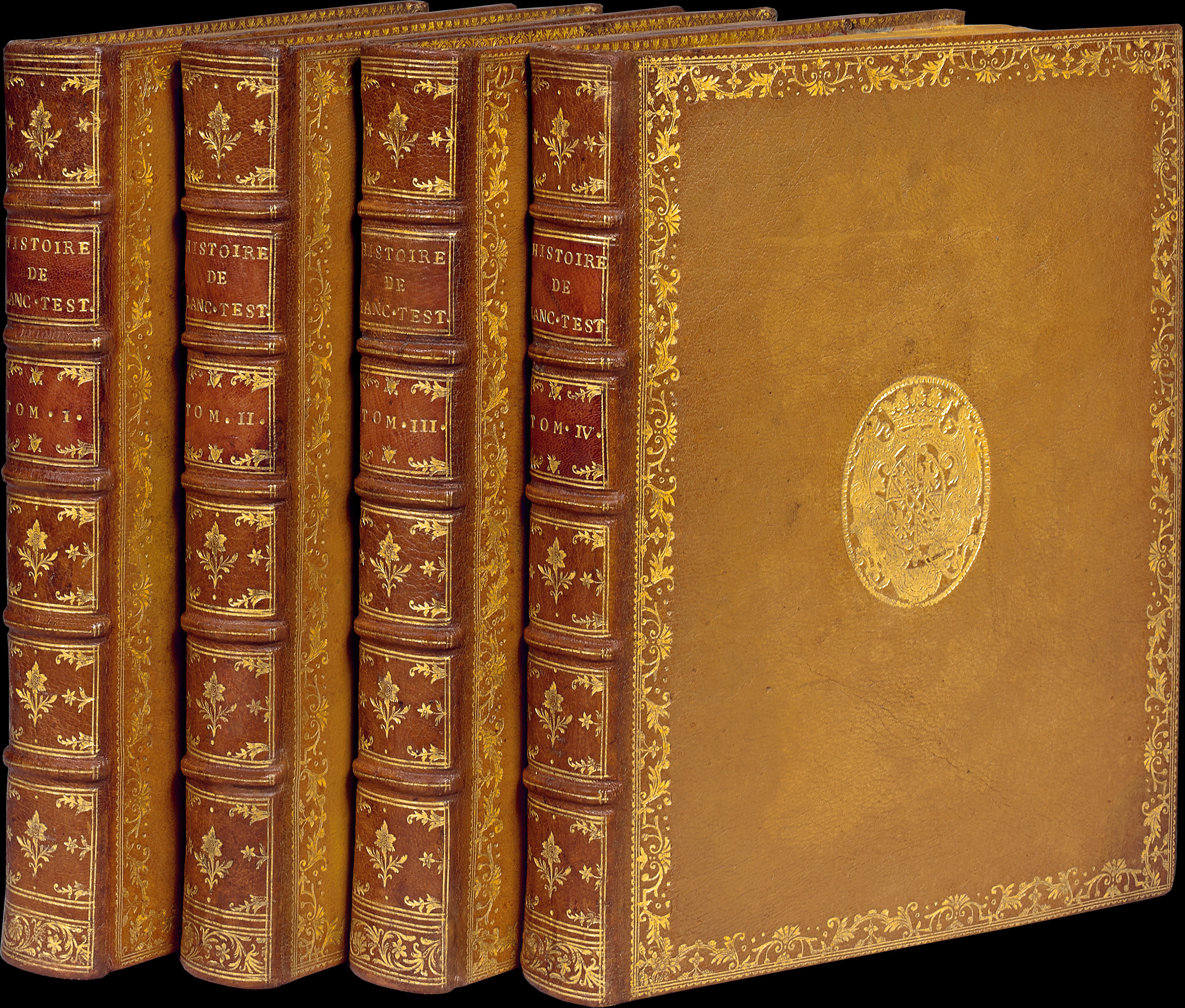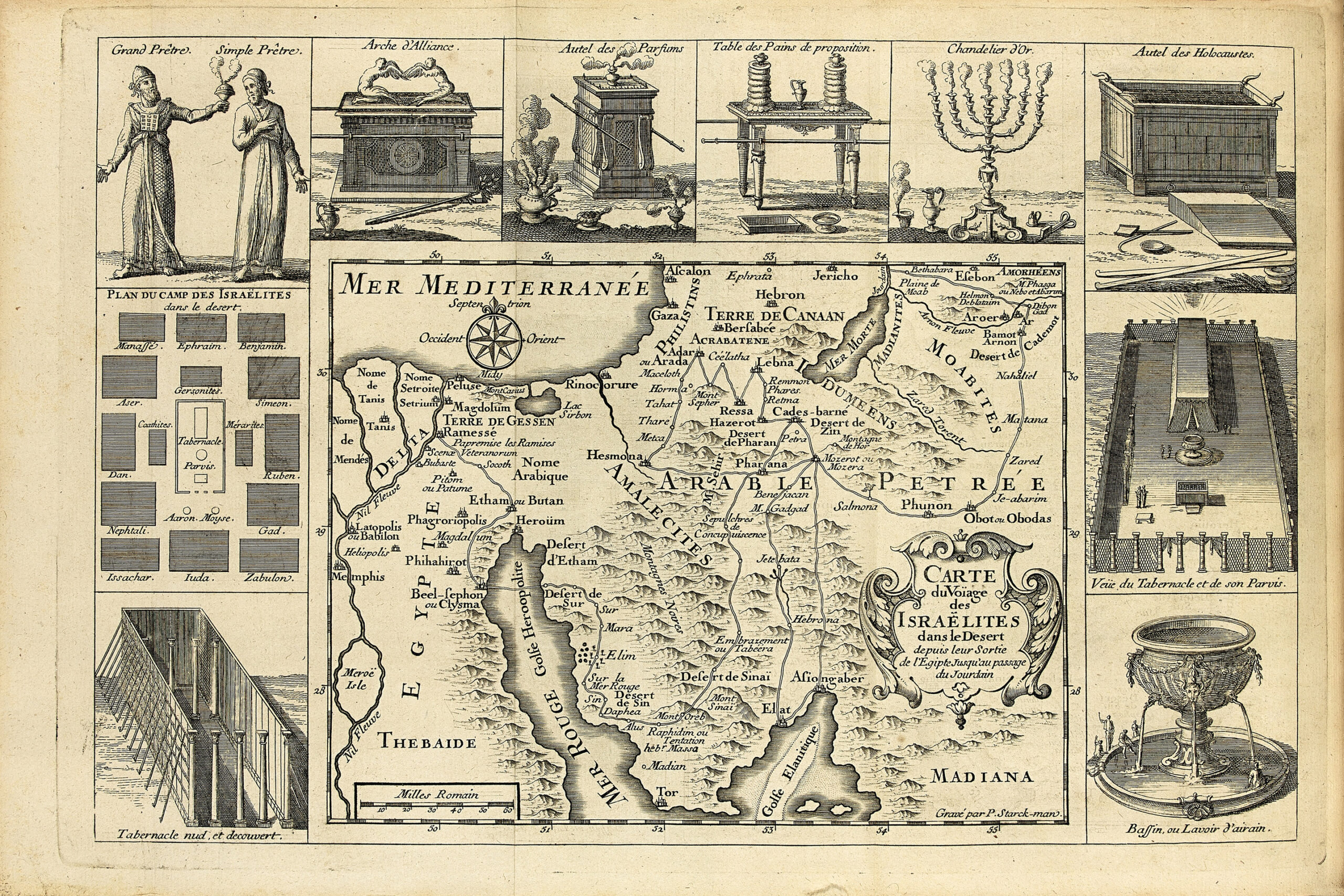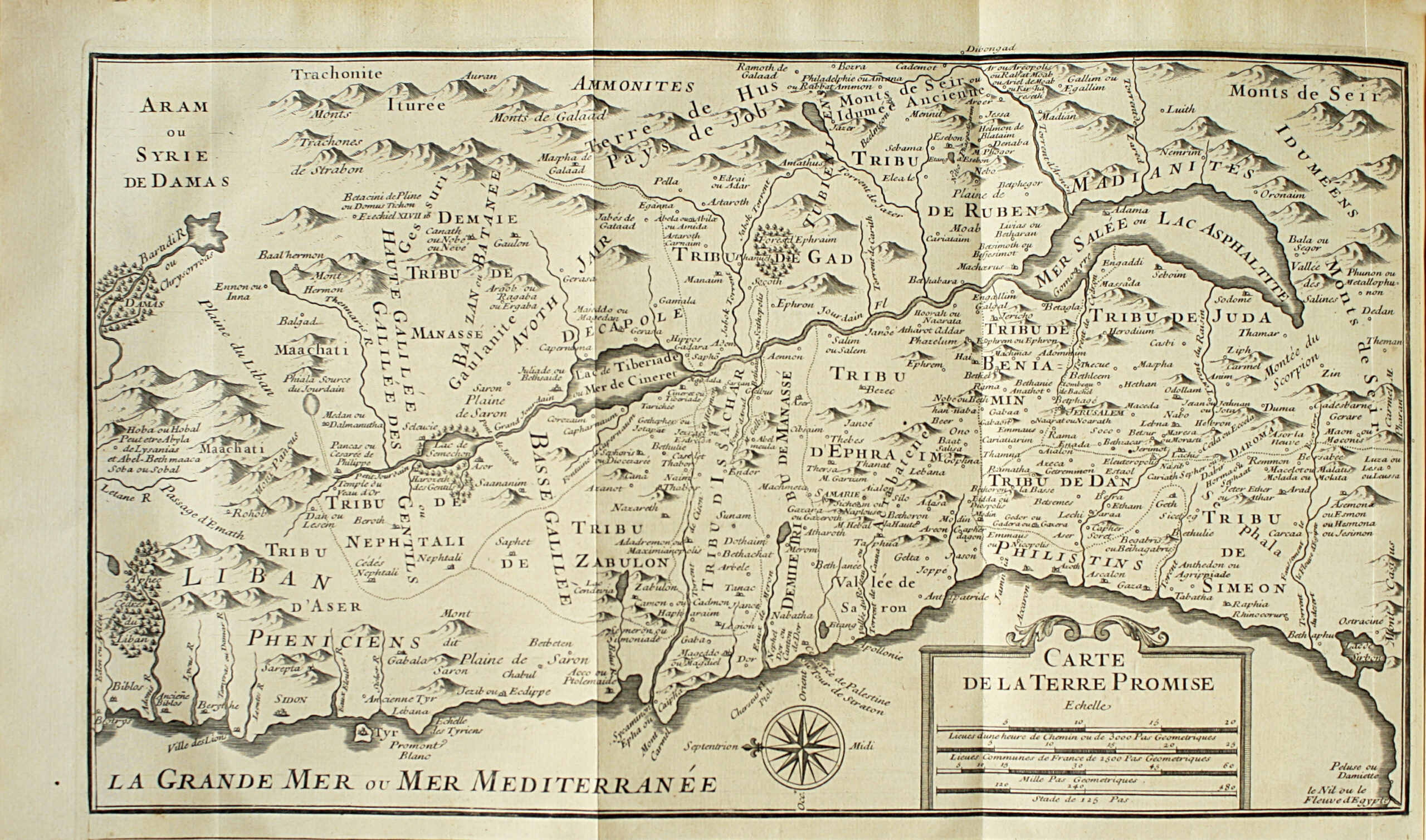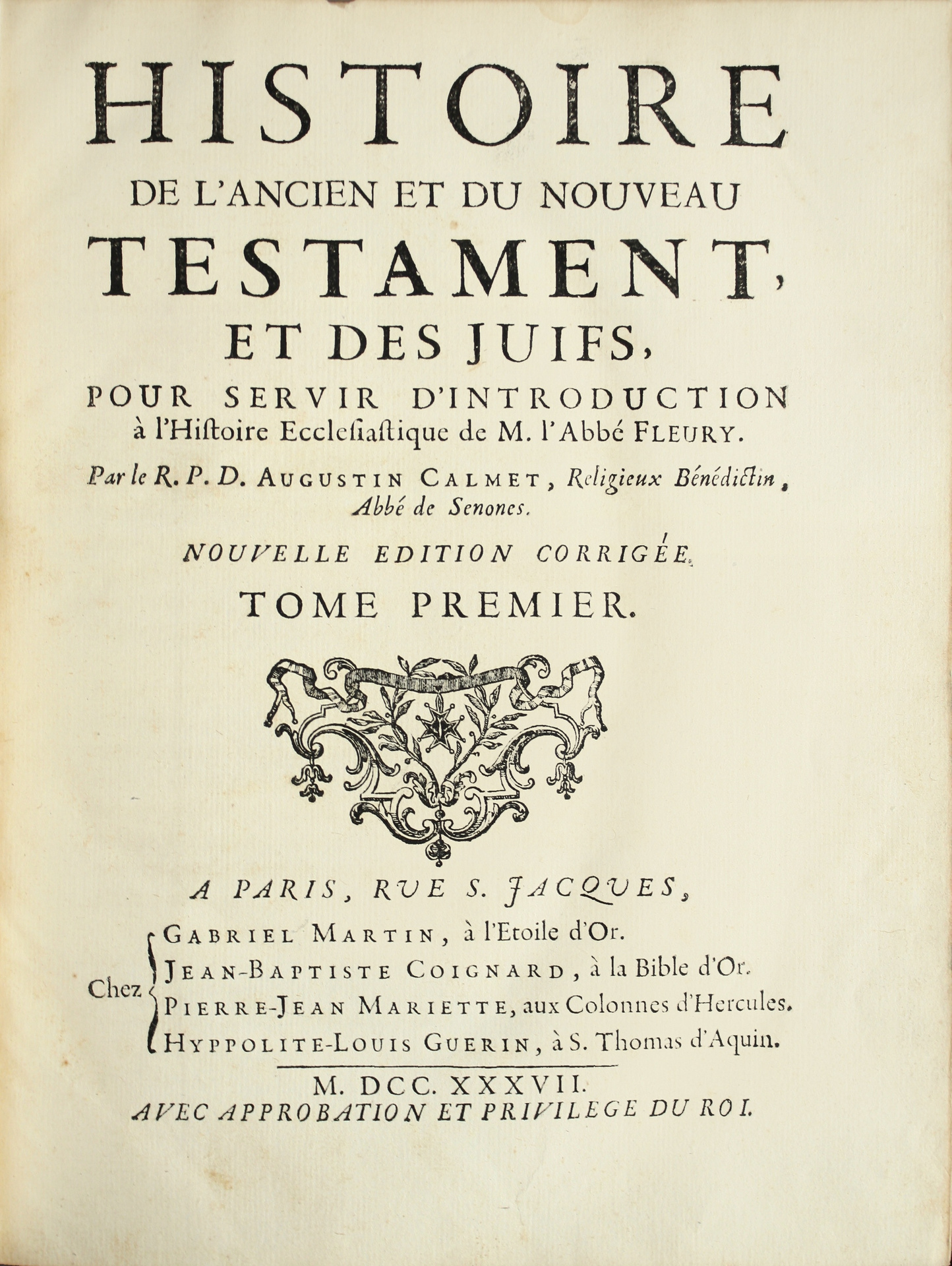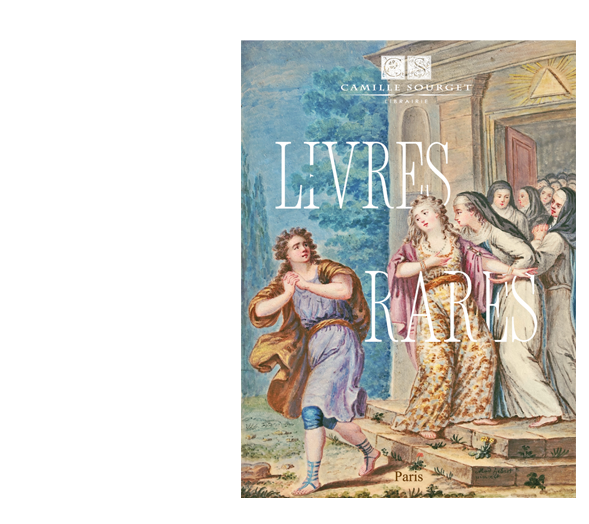Paris, Martin, Coignard, Mariette, Guérin, 1737.
4 volumes 4to [256 x 197 mm] of: I/ xvi, 140 pp., 516 pp., 4 folding maps; II/ (2) ll., 676 pp., 2 folding maps; III/ (2) ll., 676 pp., 1 folding map; IV/ (2) ll., 665 pp., (1) p. of notice to the binder, 1 folding map. Bound in citron morocco, gilt lace frame around the covers, arms gilt-stamped in the center, spines ribbed luxuriously decorated, inner border, gilt edges. Contemporary binding with arms.
The reference edition of Don Calmet’s “Histoire des Juifs”, the first complete and the only one mentioned by Brunet in the 4to format. It is illustrated with beautiful folding maps:
1. Map of the ancient world following the sharing between Noah’s children. After their dispersion in Babel.
2. Map of the earthly Paradise in Chaldea and Armenia.
3. Map of the Israelites’ journey.
4. Map of the Promised Land.
5. New Plan of the Old Jerusalem.
6. Solomon’s Temple.
7. The Temple rebuilt by Herodes.
8. Map of the Mediterranean Basin from Galileo to Sicily.
Benedictine of the St. Vanne Congregation, Antoine Calmet (Dom Augustin) was one of the most useful writers produced by the Order of St. Benedict.
As long as Calmet lived, Voltaire showed respect, deference and admiration to this learned writer. He even went to visit him at the Senones Abbey, and in the letter in which he asked him for permission, he spoke as follows: “Je préfère, monsieur, la retraite à la cour, et les grands hommes aux sots… Je veux m’instruire avec celui dont les livres m’ont formé, et aller puiser à la source… Je serai un de vos moines. Ce sera Paul qui ira visiter Antoine, etc (1748)“. We don’t know why this project was not executed before 1754. There, Voltaire lost no time; in the middle of his library, and with the indications of Dom Calmet, he found great help in rebuilding his Histoire Générale of which a false edition had just been published. He “scoled his imagination”, as he wrote himself, by reading the Fathers and the Councils, the old historians of France and the Capitulars of Charlemagne. After six weeks, he left Senones for Plombières. “I will take the waters, he wrote, not believing in them, as I have read the fathers”. He needed, moreover, to conceal to his respectable host his disposition to incredulity, as witnessed in this letter he wrote himself from Plombières: “Je trouvais chez vous bien plus de secours pour mon âme que je n’en trouve à Plombières pour mon corps. Your works and your library educate me more than the waters of Plombieres relieve me, etc » It is certain, at least, that, for his Essai sur les Mœurs des Nations, Voltaire owes a great deal, not only to the reading and the research he was able to do at Senones Abbey, but also to the many loans he allowed himself, without any bragging, to commit towards Calmet’s Histoire Sacrée et Profane.
Dom Calmet is the manifestation of a clerical world that raised, sometimes clumsily, always with passion, the challenges of a time. He is at once the heir of centuries of scholarship and slow maturation of knowledge, and the clerk inserted in the networks of his time. Neither credulous nor modern, he is the emblematic figure of a monasticism that tried to adapt to the world of “the crisis of European conscience”.
The Benedictine order is then flourishing. Dom Calmet lives during a period crossed by debates (Jansenist crisis, emergence of the Enlightenment ideas) and marked by developments in scholarship (mutation of biblical criticism, renewal of historical methods). Dom Calmet, exegete and historian rooted in his time, is interested in all these questions.
His life is divided into four stages:
His training (until 1704), his stay in Paris (1706-1716), his roots in Lorraine (1718-1729), his abbatial office in Senones (1729-1757). He has a vocation of scholar but not that of the charge of souls or preaching: the characteristics of the St. Vanne Congregation meet his aspirations; he is deeply attached to the latter. He has various responsibilities there including that of abbot. His stay in Paris (at the Blancs-Manteaux Monastery) is very important is his journey. He meets there influent personalities of the time such as Dom Mabillon. He begins to build relationships with booksellers. Dom Calmet is thus integrated in the “Republic of Letters”; over time, he builds a close network of correspondents and collaborators.
History then fascinates the public. A large number of his contemporaries see Dom Calmet as a great historian. He publishes both books of religious history and secular history. Emblematic figure of the Benedictine scholarship in the tradition of Dom Mabillon, he conceives history on various scales, from the local to the universal, and wishes to stand out from the tradition of the annals and chronicles. He goes to libraries and archives places for his research and is being helped by collaborators. He shows critical sense and rigor.
He meets success with bourgeois elites. Thanks to his links with many booksellers, the diffusion of his works is wide, especially to the German world and Central Europe. His desire for popularization, to which writing in French participates, allows him to reach a varied audience, including women. The public lends itself to various types of readings: scholarly, critical and controversial. His treatises on exegesis meet a great success throughout the 18th century.
Precious and admirable volumes bound in delicious citron morocco for the count Henri de Calenberg, Chamberlain of the Emperor, General Colonel, Lord of the House of the Elector of Saxony and Provost of the Chapter of Misnie, in Saxony; born on February 10, 1685, died on April 27, 1772. He married Marie-Therese-Bernardine, Marquise of Paskal, born on April 29, 1686, died on April 23, 1747.
“Magificent library of which “most of the volumes were bound « in red, blue, yellow, violet, green, citron morocco and other precious ligatures…» as mentioned on the title of the catalogue listed here: « Catalogue d’une très riche collection des livres, tableaux et estampes très bien conditionnés, et la plupart des livres reliés en maroquin.., de feu S. E. le comte de Calenberg, général d’infanterie, chambellan de LL. MM. I. R. et A…, sous la direction de J. Ermens. – Bruxelles, J. Ermens (1773), in-12, 2048 numéros. » (J. Guigard).
